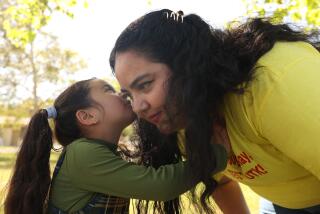At Age 5, Not Too Young for Technology
- Share via
It had been amazingly quiet for a room of 34 kindergartners, but the truly surprising part came when the 20-minute lesson ended: The computer screens flashed the words, “That’s all for today,” and there was a collective “awwwwww” of disappointment from the class.
“You know, when we teachers finish a lesson, they rarely say ‘awwwwww,’ ” laughed Jo Menely, a teacher at Beatty Elementary School in Buena Park.
Computers, which have made their way into offices and homes, colleges and high schools across the country, are now working their way into elementary schools. Since January, even the kindergartners at Beatty have been using them as part of a pilot program.
Menely called the computer “another tool” for teaching, like books or blocks or a teacher reading stories to a class. But she said it is an excellent tool “because computers are not of the future, they are now. And there is no part of our lives that is not touched by computers. So I think we have to make these children computer literate.”
On a sunny morning this week, groups of 5-year-olds filed into the school’s computer lab, where long tables held IBM machines placed side by side. The students donned headsets to receive instructions from a master computer disk, pushed a button and received a customized lesson plan.
“Lupe, which has a DIFFERENT use?” flashed onto one screen. Below the words were a ski cap, a helmet, a fedora and a sneaker. Using the hand-held device known as a “mouse” to steer a pointer on the screen in the desired direction, Lupe Valdez picked the sneaker. She was right.
Occasionally a student emitted a squeal of delight at getting the right answer, but the yelps went unheeded by the other children because all had headsets on. Teacher Magda Alfonzo roamed the room, working with children who requested help and monitoring their progress.
Menely feels kindergarten is the minimum age for a child to start learning with computers. Due to the short attention span of a young child, the classes with the machines are limited to once a week, 20 minutes at a time, she said. Still, for children who grow up with television and computer games, learning to use a computer at school is no big deal, Menely said.
In the pilot kindergarten program at Beatty, the machines are used for math, reading and language skills. One obvious asset is that the computers, with their 16-color graphics and animation possibilities, are fun. Also, the headsets have microphones, allowing students to practice pronunciation if the lesson plan calls for it.
“I like to play with it,” 5-year-old Kevin Strate said of his computer. “I like to do stuff on it. I like to find stuff that looks alike and put stuff in boxes.”
Phil Keith, the Laguna Niguel-based sales representative for Education Systems Corp., said his firm’s computer programs are being used by more than 350,000 elementary school students nationwide, including thousands of kindergartners besides those at Beatty. Although a wonderful asset, computers will never replace teachers, Menely said.
“It lacks the personal touch, of course, that you have with a teacher, the teacher’s rapport with the class. A machine will never replace the interest, the insight that a teacher has, the ability to change, to accommodate individual needs and to just be supportive of the student.”
More to Read
Sign up for Essential California
The most important California stories and recommendations in your inbox every morning.
You may occasionally receive promotional content from the Los Angeles Times.













